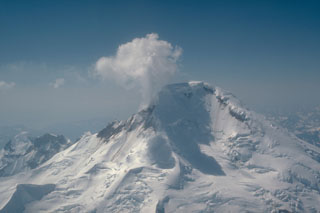Report on Iliamna (United States) — September 1997
Bulletin of the Global Volcanism Network, vol. 22, no. 9 (September 1997)
Managing Editor: Richard Wunderman.
Iliamna (United States) Seismic swarm ends in March
Please cite this report as:
Global Volcanism Program, 1997. Report on Iliamna (United States) (Wunderman, R., ed.). Bulletin of the Global Volcanism Network, 22:9. Smithsonian Institution. https://doi.org/10.5479/si.GVP.BGVN199709-313020
Iliamna
United States
60.032°N, 153.09°W; summit elev. 3053 m
All times are local (unless otherwise noted)
A seismic swarm that began on 1 August 1996 (BGVN 21:08) continued during late 1996 and into early January 1997 (BGVN 21:09, 21:10, and 21:12) with earthquakes occurring at a rate of 11/day. Activity began to decline during 11-17 January, when only two events/day were recorded. The swarm continued through 24 January at an average rate of less than one earthquake/day, a significant reduction from the rate two weeks earlier. Seismic activity through the end of February averaged 2-5 events/day. Earthquake counts decreased again during 1-7 March to a rate of 1/day, then decreased to only one locatable earthquake during the week of 15-21 March. By 28 March seismicity was reported to be at background levels.
Iliamna is a deeply dissected stratovolcano 225 km SW of Anchorage in the Aleutian Range. The volcano is almost entirely covered with perennial snowfields and valley glaciers. A prominent fumarole field near the summit produces steam plumes that are commonly visible from Anchorage and the Kenai Peninsula on clear days.
Geological Summary. Iliamna is a prominentglacier-covered stratovolcano in Lake Clark National Park on the western side of Cook Inlet, about 225 km SW of Anchorage. Its flat-topped summit is flanked on the south, along a 5-km-long ridge, by the prominent North and South Twin Peaks, satellitic lava dome complexes. The Johnson Glacier dome complex lies on the NE flank. Steep headwalls on the S and E flanks expose an inaccessible cross-section of the volcano. Major glaciers radiate from the summit, and valleys below the summit contain debris-avalanche and lahar deposits. Only a few major Holocene explosive eruptions have occurred from the deeply dissected volcano, which lacks a distinct crater. Most of the reports of historical eruptions may represent plumes from vigorous fumaroles E and SE of the summit, which are often mistaken for eruption columns (Miller et al., 1998). Eruptions producing pyroclastic flows have been dated at as recent as about 300 and 140 years ago, and elevated seismicity accompanying dike emplacement beneath the volcano was recorded in 1996.
Information Contacts: Alaska Volcano Observatory (AVO), a cooperative program of a) U.S. Geological Survey, 4200 University Drive, Anchorage, AK 99508-4667, USA (URL: http://www.avo.alaska.edu/), b) Geophysical Institute, University of Alaska, PO Box 757320, Fairbanks, AK 99775-7320, USA, and c) Alaska Division of Geological & Geophysical Surveys, 794 University Ave., Suite 200, Fairbanks, AK 99709, USA.

